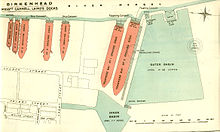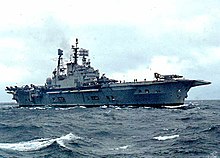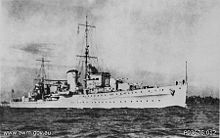Cammell, Laird & Company

Cammell, Laird & Company is a British shipbuilding company founded in 1903 in Birkenhead on the River Mersey . The shipyard delivered in 1920 with the Fullagar the world's first fully welded ship from. The company that emerged from the Birkenhead Iron Works , founded in 1824, has been operating under the acronym Cammell Laird since the end of 2008 .
history
The company was founded in 1903 through the merger of the Laird Brothers shipyard in Birkenhead, which had existed since 1828, with the Sheffield-based metal construction company Charles Cammell & Co.Although the majority of the ships built by the end of World War II were cargo ships of all kinds, the shipyard became primarily for the large number of warships and passenger ships built here, but also repeatedly known for innovations in shipbuilding.
The beginnings
Immediately after the merger, the shipyard was expanded to the south and modernized. Among other things, in the spring of 1904 the foundation stone was laid for an approximately 100 meters long, over 20 meters wide and almost 17 meters high rolled steel plant, which was called "The Cathedral" because of its size. With this system, powered by a 12,000 hp steam engine, called the River Don Engine, it was possible to produce even the thickest armor plates for the construction of warships, but due to a lack of other orders, it was initially only able to complete smaller ships and therefore made up to 1909 only loss. Cammell's solid capital base was just as important for the development of the shipyard during the expansion as its extensive know-how in metal processing. In addition, the British Admiralty preferred new construction contracts for the Royal Navy shipyards, which offered all production processes in-house. William, John and Henry Laird had since died and the company was led by sons J. Macgregor Laird, Roy M. Laird and JWP Laird and Ratsey Bevis. In 1913, Cammell Laird was already producing 15,000 tons of armor plate 5 cm thick and thicker.
The St. George canal ferry, built in 1906, was one of the first of these vehicles with a steam turbine drive and operated on the route between Fishguard and Rosslare Harbor . In 1909, the world's largest suction dredger, Leviathan, was built for Mersey Docks & Harbor Co. , followed by a number of combi ships for mainly South American clients. This was followed by several passenger ships for the Norway-America line. The company manufactured all kinds of castings and forgings, armor and projectiles were also manufactured, and machine and boiler construction were operated. In 1912 the largest floating dock in the world was completed on behalf of the British Admiralty . It was 640 feet long and weighed 32,000 tons. In the same year William Lionel Hitchens became chairman of the board of directors and remained so until 1940. Thus no member of the Laird family was more involved in the management of the company.

The until then largest ship in the yard was the battleship HMS Audacious , which was delivered on October 21, 1913 . A good year after its commissioning, it ran into a mine off the Northern Irish coast and sank.
An unusual new building was launched on January 17, 1914 on the Leonard train ferry . Until 1920 it served the National Transcontinental Railway Company of Canada as a kind of floating bridge to cross the St. Lawrence River . After the Québec Bridge was completed, the Leonard was converted into a tanker.
First World War

During the First World War , Cammell Laird delivered five C-class light cruisers , six destroyers and two escort vehicles to the Royal Navy . In addition, the construction of submarines began for the first time in 1915 , starting with the E41 of a series of eight boats. During the First World War, due to Norwegian neutrality, the construction work for Norwegian shipping companies could be continued with a special permit from the British government. In addition, over 500 ships were repaired in Birkenhead, and several steamers were prepared and rebuilt for war use. A seaplane carrier and three "WAR" standard freighters and two "AO" series tankers were also completed.
Between the wars
Begun during the war, the world's first fully welded ship, the Fullagar , came from Cammell Laird in 1920 . In the same year, the RMS Samaria , the second of three Cunard passenger ships, was also delivered from Birkenhead. During the 1920s, battleships and destroyers for the Royal Navy, cargo ships and 44 passenger ships were built.
In 1927 Robert S. Johnson, who was previously managing director of the Workman, Clark and Co. shipyard , took over the management of the late Sir George Carter and remained with the company as chairman of the board from 1942 until his death in 1951. Robert S. Johnson's son Robert W. Johnson became managing director and remained so until the 1960s.
In 1929, the railway division of Cammell Laird with the Metropolitan Railway Carriage and Wagon Co. became the Metropolitan-Cammell Carriage and Wagon Company Ltd. (MCCW - Metro Cammell) merged, steel production was combined with that of its competitor Vickers , which is only half a mile away, to form the English Steel Corporation .
From 1931 to 1933 the shipyard was closed due to the global economic crisis . Through the Depression , the company's capital was on £ 3.5 million in 1932 pounds melted. It could only be reopened thanks to a few orders from the Admiralty . Among the 22,000 ts then largest new construction shipyard, the 3 million pounds expensive Ark Royal , which was lowered into the water 1937th From 1935 to 1939 more than 20 large and small tankers, ferries, but also large lakes freighters , so-called "Laker" were completed in Birkenhead . Probably the most famous passenger ship of the shipyard, the second RMS Mauretania of the Cunard shipping company , was handed over in May 1939.
On June 1, 1939, a new "T" class submarine sank on a shipyard test drive. 99 members of the navy and shipyard died in the Thetis , only three men of the crew survived.
Second World War
A total of 106 warships were built during World War II , roughly equivalent to the completion of one ship every three weeks. In the spring of 1941, the HMS Prince of Wales was put into service, which became known in May of the same year for the hunt for the German battleship Bismarck . In addition to the aircraft carrier HMS Venerable , which was sold to the Netherlands in 1948, Cammell Laird built a number of cruisers, destroyers, submarines and sloops , but also many civilian ships. These included tankers, which were among the largest of their time, but also refrigerated ships for the shipping company Shaw, Savill & Albion Steamship Co. and others. In addition to the construction of tugs for use on the Mersey, over 2,000 ships of all kinds were repaired.
HMS Dido (1940)
HMS Prince of Wales in Singapore Harbor (December 1941)
Post-war period until nationalization
In the course of the 1950s, tankers, cargo ships for liner services and bulk carriers , but also an aircraft carrier and a large passenger ship, were mainly produced. In total, more than 60 tankers came from Cammell, Laird from 1947 to 1982, 39 liner cargo ships from 1946 to 1966 and 15 ferries between 1946 and 1968. After the corporate form was changed in 1953, in 1961 Cammell, Laird employed 12,000 people. After Shell had gained initial experience with gas turbine propulsion with its Auris tanker in 1956 , Cammell Laird built the first new build with such a propulsion system, the Sepia, in the same year . Although the shipyard gained a lot of experience with steam and gas turbine drives, especially through numerous warship newbuildings, Cammell Laird never built diesel engines.
The delivery of the Windsor Castle to the Union-Castle Line in 1960, the yard's largest and last classic passenger ship, heralded the next decade with another high point. In 1965, Cammell, Laird & Company was split into a shipbuilding company, Cammell Laird - Shipbuilders and Engineers and the repair company Cammell Laird Shiprepairers Ltd. on. The latter built Dock No. 5 ( Princess Dock ) in order to position itself better in the repair market with this large dry dock. Towards the end of the 1960s, two Resolution-class nuclear submarines, the Renown and Revenge, were delivered, at the same time there was a brief financial crisis, as a result of which in 1972 the Labor government took over 50% of the company, which then traded as Cammell Laird Shipbuilders . The Laird Group kept the other half of the shares, but continued to suffer from reluctance to take on new construction orders from former shipyard customers.
In the 1970s, six so-called “standard designs” were offered: two general cargo ship types for liner service, three of which went to Pacific Steam Navigation Company , two types of bulk carriers and the two tanker types “StaT32” and “StaT55”, which were used for various shipping companies were built worldwide. But three container ships were also built for Canadian Pacific and two tankers for P&O . On July 1, 1977, the shipyard group was incorporated into the state-owned British Shipbuilders Corporation . The new shipbuilding hall was inaugurated the following year.
From privatization to today
During the 1980s, tank construction was ended and production was switched to drilling rigs in the wake of growing oil production in the North Sea . This time was marked by extensive work stoppages, which brought shipbuilding to a complete standstill for a long time and led to the temporary closure of the shipyard. The workforce was split into two camps, some of which continued to strike or wanted to resume work, and it was not until the mid-1980s that the shipyard was run normally again. After Cammell Laird left Vickers Armstrongs Ltd. was taken over from Barrow-in-Furness , was reprivatised in 1986 under the umbrella of Vickers Shipbuilding and Engineering Ltd (VSEL) , where it was intended as a pure construction yard for warships.

As early as October 1990 it was decided to give up shipbuilding at Cammell Laird and after the submarine Unicorn had been handed over to the Royal Navy on June 25, 1993 , the shipyard was closed on June 30, 1993 on the basis of a maintenance and repair status . However, the dry docks were put back into operation in 1994 under the management of Coast Line Industries , again managed as Cammell Laird and expanded to include repair yards in France , USA and Gibraltar . Metro-Cammell , the Birmingham-based railway division of the company, became GEC-Alstom with GEC Traction during the 1990s and was completely incorporated into the Alstom Group until it was closed in 2004 .
In 2000 the company ran into financial difficulties , caused by the non-acceptance of the midship section valued at 50 million pounds (£) for the extension of the cruise ship Costa Classica by the shipping company Costa Crociere . After the company failed to win two new construction contracts for cruise ships from the American Luxus group, it was taken over by the A&P Group in 2001 with its four shipyards . Furthermore under the name Cammell Laird Gibraltar Ltd. the Royal Dockyard shipyard in Gibraltar is operated, which was also separated from the group in 2001 through a management buy-out . In November 2004, a study on the future prospects of the Cammell-Laird site, which was carried out on behalf of the Wirral Council, found that the shipbuilding and repair yard would probably not survive there in the long term. This, in turn, had Reddington Finance, the owner of the southern site with the Helgen and the shipbuilding hall, reveal controversial plans for how the area could be developed, and in December 2004 the purchase of the north site with the docks and the equipment pier for 30 million euros was also announced. £ made public. The A&P Group and Northwestern Shiprepairers & Shipbuilders leased the north site back in order to be able to carry out ship repairs there. Reddington's plans to convert the south site into a recreational, retail and entertainment area with offices and luxury living space at a cost of around £ 1 billion are not without controversy, as the connection to the long shipbuilding history could be lost. However, the planners see this aspect being preserved for the northern part of the site by a maritime visitor center. Critics warn that the aircraft carriers of the Queen Elizabeth class entering service with the Royal Navy from 2014 must also be provided with appropriate docking facilities. Dry dock number 5 could be of strategic importance as it is one of only five of the largest docks in the UK where this class of ship can be docked. Further considerations are to develop a scrapping center similar to the Able UK Ship Recycling Center in Hartlepool . Since November 17, 2008, the shipyard has been operating under the traditional name of Cammell Laird again.
Existing ships
Apart from the younger ships from Cammell Laird, of which two Sheffield-class destroyers (Type 42) and the guided missile frigate HMS Campbeltown (F86) are still in service with the Royal Navy, some historical examples of shipbuilding from Birkenhead have also survived. In Peru, the 1904 gunboat America has been preserved as a memorial to the war with Colombia in 1911. It was built by Tranmere Bay Development Co. and the shipyard John Jones & Co, which had to develop a small area next to Cammell Laird in Tranmere . The former Manchester Ship Canal Co. tug and tour vehicle Daniel Adamson from 1903 comes from the same shipyard, which was recently rescued from being scrapped and is now being restored. The 1914-built light cruiser HMS Caroline is part of the Royal Naval Reserve in Belfast, which in 1966 created submarine HMS Onyx the Oberon class serves as a museum ship in the Historic Warships Collection in the Birkenhead docks. The Manxman steamer of the Isle of Man Steam Packet Company , which was commissioned in 1955 , also still exists and is due to return to Merseyside for restoration through an action by the Manxman Steamship Company .
Cammell Laird & Company ships (selection)
Aircraft carrier
- HMS Ark Royal (1937)
- HMS Ark Royal (1950)
- HMS Venerable
Battleships
cruiser
Sloops
destroyer
Submarines
- 3 Shark class boats
- 17 Seraph class boats
- 15 Subtle class boats
- 3 Tempest class boats
- 4 Triton class boats
- 2 atomic submarines the resolution class
- 1 Churchill-class nuclear submarine ( HMS Conqueror )
- 2 Upholder class boats (Victoria class)
Passenger ships
Cargo ships
literature
- Warren, Kenneth: Steel, ships and men . Liverpool University Press, Liverpool 1998, ISBN 0-85323-912-6 .
- H. Clarkson & Co. Ltd. (Ed.): The Clarkson Chronicle . 1852-1952. Harley Publishing, London 1952.
- Germanischer Lloyd (Ed.): International Register 1881 . Germanischer Lloyd, Berlin 1881.
Individual evidence
Web links
- Shipyard description viewed on July 27, 2009
- Shipyard description viewed on July 27, 2009
- Shipyard report viewed July 27, 2009
Coordinates: 53 ° 23 '16.6 " N , 3 ° 0' 39.1" W.









